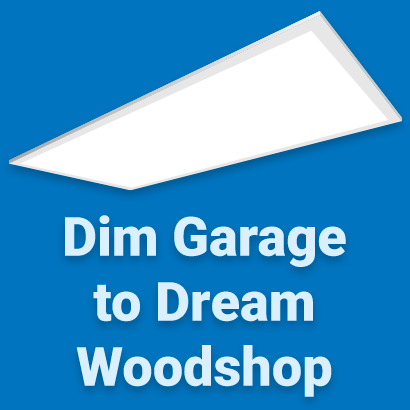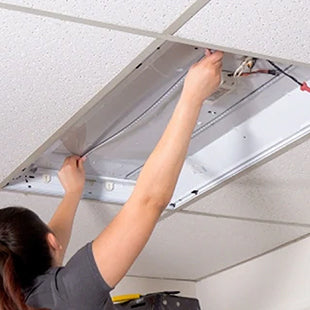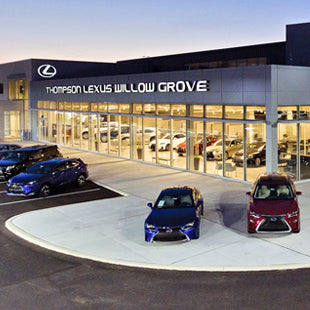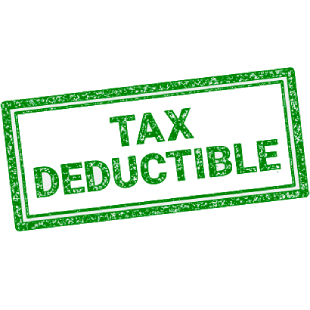How to Light Your Warehouse, Fulfillment Center, Distribution Center, or 3PL
Whether your facility's focus is on storing or moving objects, lighting is key to ensuring that productivity, safety, and energy efficiency are maximized. Getting lighting wrong can mean unnecessary energy expenses, increased workers' compensation filings, and slower pick and pack rates. Here are the factors to consider when selecting the lighting for your warehouse, fulfillment center, distribution center, or third-party logistics (3PL) operation.
The Five Facets of Getting Lighting Right for Warehouses and Distribution Centers
Illuminance: The Right Amount of Light
Understanding the foot-candles required for different tasks in the warehouse, such as picking, packing, or sorting, is step number one. Foot-candles measure the quantity of light that reaches a surface. Getting this right is crucial in warehouses. Falling short hinders visibility, and that can be costly in terms of increased accidents and decreased productivity.
Below are recommended foot-candle guidelines for common applications in and around warehouses and logistics centers.
Sample Lighting Guidelines for Common Warehouse Areas
|
Warehouse - Open or with Aisles |
10-30 fc |
|
Warehouse Inactive Area |
5-10 fc |
|
Warehouse Active Area - Small Items |
15-60 fc |
|
Warehouse Active Area - Bulky Items |
10-20 fc |
|
Shipping and Receiving |
30 fc |
|
Packing and Sorting |
10-30 fc |
|
Office and Administrative |
30-50 fc |
|
Lunch & Break Rooms |
3-10 fc |
|
Restroom |
5 fc |
|
Hallway |
10 fc |
|
Stairway |
5 fc |
|
Loading Dock |
5-20 fc |
|
Parking Lot |
2-5 fc |
|
Parking Garage |
1-2 fc |
Distribution: Light in the Right Place
Shadows and glare contribute to accidents, eye strain, and suboptimal productivity. You'll want to ensure that your lighting is evenly distributed across the entire warehouse space & that the correct beam angle is chosen for the lighting you install. There are basic online calculators to give you rough self-help assistance in determining your lighting layout. For the best results, though, rely on the pros.
When our team does a high bay layout for a customer, they use Illuminating Engineering Society (IES) Illuminance Tables to determine the foot-candles required for each area. Then they take the area's square footage, fixture mounting height, fixture beam angle, lumen output per fixture, and fixture efficiency into account to determine the total lumens needed to achieve the recommended foot-candles and the number of fixtures required to hit that target.
Finally, to calculate fixture spacing they consider the layout of the area, including shelves, machinery, and other obstructions that might affect the light distribution.
Online self-help calculators have the advantage of being free, but going into your lighting installation with a professional layout in hand is worthwhile for a couple of reasons:
- You get the right lights and number of lights to meet your needs on the first try—no returns or additional orders needed.
- Your installer has a plan to reference to ensure the results are what you expect & that his job is done more easily and quickly.
That's why when customers source their lights through ELEDLights, we give them access to the expertise of our in-house lighting pros—including professional lighting layouts for their projects—at no additional cost.
↳ Learn more about or request a free high bay lighting layout for your warehouse
If you'll need lighting controls or emergency backup drivers, be sure to mention that to our team as well. In addition to the lighting plan itself, they'll provide you a quote for all the lights and accessories you'll need for the job. If you're renovating an existing building or overhauling your old lighting, our lighting pros will also let you know what financial incentives might be available to you from your property's utility provider. And they can help you access those incentives to offset the cost of your new lighting.
Color Rendering & Temperature: The Right Quality of Light
Depending on the goods you're storing or moving, color rendering can be an important factor to consider. A light's color rendering capability affects the way colors appear under different lighting conditions. For most warehouse and fulfillment uses, you'll want lights with a color rendering index of >80. If you deal with very small items or very small labels, a higher color rendering index can be helpful, but be aware that the tradeoff for higher color rendering is lower efficiency.
As far as color temperature goes, we've found that cool white—5000K—is generally preferred for our customers' warehouse and distribution/fulfillment center applications. If you require something warmer or cooler, let us know; we can do special orders for most requirements.
Energy Efficiency: The Long-Term Investment
Energy efficiency and lamp longevity determine the long-term cost of operating your lighting system. Every lighting system converts only a portion of the energy it consumes into visible light; the rest is wasted in heat. Remember how hot incandescent bulbs would get? 90% of their energy was expended to heat, and a mere 10% of their energy consumption went toward producing visible light.
In other words, 90% of what you paid to run your incandescent lights was wasted on a bunch of hot air.
Here's the energy breakdown of some common lighting systems used in warehouses, distribution centers, and other large, high-ceiling spaces:
Average Energy Consumption Breakdown of Various Lighting Systems
|
Fluorescent |
Metal Halide |
LED |
|
60-70% Heat |
65-75% Heat |
10-20% |
|
30-40% Visible Light |
25-35% Visible Light |
80-90% Visible light |
As you can see, 80-90% of what you pay to run LED lights actually goes toward producing light. This significantly lowers bills compared to metal halide lamps or even fluorescent technology.
What Energy Efficiency Means to Your Bottom Line
Take a warehouse with thirty 6-lamp HO fluorescent fixtures. Each one of those fixtures is pulling 324 Watts. Operating these lights 12 hours a day 7 days a week at a rate of 12 cents/kWh would cost more than $25,000 over the course of five years, not including the labor and materials costs for the 180 or so lamp replacements you'd have to make during that period.
Meanwhile, thirty 130W linear LED high bay lights would cost just $10,000 to run over the same five years, with virtually no lamp replacements needed during that time. This is a savings of $15,000.
If your warehouse is in a high-energy-cost location, the number can be much higher. In California, you'd be looking at nearly $30,000 in energy savings.
These numbers don't even consider the reduction in air conditioning costs you may see due to LED lighting's lower operating temperatures, or the savings in maintenance costs you enjoy with lamps that last twice as long as fluorescents.
Even comparing LED to LED, knowing what your real needs are can make a significant difference in energy costs. For example, specifying a higher color rendering index than your application requires can cost you in energy efficiency, sometimes by as much as 40% to 50%. Likewise, focusing only on energy efficiency could cost you more in warehouse labor when a too-low color rendering index hampers productivity. This is another way a professional lighting layout can produce more wholistic results than an online calculator.
Durability: The Protection for Your Investment
When you're buying lights rated to last 50,000 operating hours or longer, you'll want to make sure you opt for fixtures that are durable, easy to maintain, and resistant to dust, moisture, and other environmental factors commonly found in warehouses. There's no point having long-lasting LEDs if the housing isn't going to withstand your operating conditions.
LED lights are often available with polycarbonate lenses and durable housing. If the conditions of your warehouse require extra protection—perhaps you're lighting a covered outdoor storage area, or your building's open bay doors let in excess humidity—look for enclosure ratings of IP65 or higher, for extra dust and water protection. If you need protection against impact, look for a rating of IK08 or higher.
If you're storing volatile gases or other hazardous substances, or if you're in a corrosive environment, such as a seaport, you can get LED lights in explosion-proof, HazLoc, and anti-corrosive/marine-grade housing.
Additional Lighting Considerations for Your Warehouse or Distribution Center
Controls
Consider incorporating smart lighting controls for your warehouse lights, such as occupancy sensors, dimmers, or, if your facility's design lets in natural light, daylight harvesting systems. These will optimize your energy usage and adapt your lighting to different warehouse needs throughout the day and seasons.
Mounting Options
Your light fixtures will need to be securely mounted to ensure safety and stability. Typically, warehouse lighting is hung by chains. This has two advantages: 1) More control over mounting height, and 2) Ease of installation. The less complicated the installation process, the lower your installer's bill will be. Other common mounting options include fixed or adjustable ceiling and wall brackets, surface mounting, and pendant or conduit mounting.
Emergency Options
Emergency backup drivers are a popular add-on for LED high bay lighting. (You may also know them as "emergency ballasts," but for LED lighting the terminology is "driver.") These drivers allow lights to continue running for 90 minutes, at reduced brightness, during a power outage. By adding drivers like these to select warehouse light fixtures, you can ensure the safety of your employees and the security of your property in the event of an emergency.
Putting It All Together
By selecting the right lighting solution for your warehouse, distribution center, fulfillment center, or 3PL company, you can improve visibility and prevent accidents, creating a safe work environment. Meeting these goals will save money on workers' comp claims, while choosing the right lighting technology and controls can help you achieve lower energy bills and higher worker productivity, year after year.
↳ Explore our LED warehouse lighting — or, more specifically, our LED UFO high bay lights and our linear high bay LED lights.





